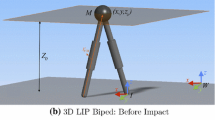Abstract.
Using tools from discrete dynamical systems theory, we begin a systematic analysis of a distributed model of leg coordination with both biological and robotic applications. In this paper, we clarify the role of individual coordination mechanisms by studying a system of two leg oscillators coupled in one direction by each of the three major mechanisms that have been described for the stick insect Carausius morosus. For each mechanism, we derive analytical return maps, and analyze the behavior of these return maps under iteration in order to determine the asymptotic phase relationship between the two legs. We also derive asymptotic relative phase densities for each mechanism and compare these densities to those obtained from numerical simulations of the model. Our analysis demonstrates that, although each of these mechanisms can individually compress a range of initial conditions into a narrow band of relative phase, this asymptotic relative phase relationship is, in general, only neutrally stable. We also show that the nonlinear dependence of relative phase on walking speed along the body in the full hexapod model can be explained by our analysis. Finally, we provide detailed parameter charts of the range of behavior that each mechanism can produce as coupling strength and walking speed are varied.
Similar content being viewed by others
Author information
Authors and Affiliations
Additional information
Received: 22 June 1999 / Accepted in revised form: 7 September 1999
Rights and permissions
About this article
Cite this article
Calvitti, A., Beer, R. Analysis of a distributed model of leg coordination . Biol Cybern 82, 197–206 (2000). https://doi.org/10.1007/s004220050019
Issue Date:
DOI: https://doi.org/10.1007/s004220050019




